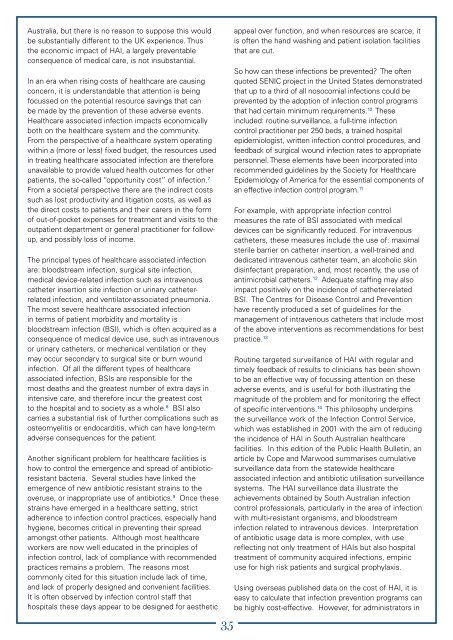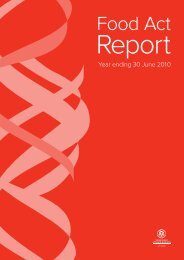Public Health and Communicable Diseases - SA Health - SA.Gov.au
Public Health and Communicable Diseases - SA Health - SA.Gov.au
Public Health and Communicable Diseases - SA Health - SA.Gov.au
You also want an ePaper? Increase the reach of your titles
YUMPU automatically turns print PDFs into web optimized ePapers that Google loves.
Australia, but there is no reason to suppose this wouldbe substantially different to the UK experience. Thusthe economic impact of HAI, a largely preventableconsequence of medical care, is not insubstantial.In an era when rising costs of healthcare are c<strong>au</strong>singconcern, it is underst<strong>and</strong>able that attention is beingfocussed on the potential resource savings that canbe made by the prevention of these adverse events.<strong>Health</strong>care associated infection impacts economicallyboth on the healthcare system <strong>and</strong> the community.From the perspective of a healthcare system operatingwithin a (more or less) fixed budget, the resources usedin treating healthcare associated infection are thereforeunavailable to provide valued health outcomes for otherpatients, the so-called “opportunity cost” of infection. 7From a societal perspective there are the indirect costssuch as lost productivity <strong>and</strong> litigation costs, as well asthe direct costs to patients <strong>and</strong> their carers in the formof out-of-pocket expenses for treatment <strong>and</strong> visits to theoutpatient department or general practitioner for followup,<strong>and</strong> possibly loss of income.The principal types of healthcare associated infectionare: bloodstream infection, surgical site infection,medical device-related infection such as intravenouscatheter insertion site infection or urinary catheterrelatedinfection, <strong>and</strong> ventilator-associated pneumonia.The most severe healthcare associated infectionin terms of patient morbidity <strong>and</strong> mortality isbloodstream infection (BSI), which is often acquired as aconsequence of medical device use, such as intravenousor urinary catheters, or mechanical ventilation or theymay occur secondary to surgical site or burn woundinfection. Of all the different types of healthcareassociated infection, BSIs are responsible for themost deaths <strong>and</strong> the greatest number of extra days inintensive care, <strong>and</strong> therefore incur the greatest costto the hospital <strong>and</strong> to society as a whole. 8 BSI alsocarries a substantial risk of further complications such asosteomyelitis or endocarditis, which can have long-termadverse consequences for the patient.Another significant problem for healthcare facilities ishow to control the emergence <strong>and</strong> spread of antibioticresistantbacteria. Several studies have linked theemergence of new antibiotic resistant strains to theoveruse, or inappropriate use of antibiotics. 9 Once thesestrains have emerged in a healthcare setting, strictadherence to infection control practices, especially h<strong>and</strong>hygiene, becomes critical in preventing their spreadamongst other patients. Although most healthcareworkers are now well educated in the principles ofinfection control, lack of compliance with recommendedpractices remains a problem. The reasons mostcommonly cited for this situation include lack of time,<strong>and</strong> lack of properly designed <strong>and</strong> convenient facilities.It is often observed by infection control staff thathospitals these days appear to be designed for aesthetic35appeal over function, <strong>and</strong> when resources are scarce, itis often the h<strong>and</strong> washing <strong>and</strong> patient isolation facilitiesthat are cut.So how can these infections be prevented? The oftenquoted SENIC project in the United States demonstratedthat up to a third of all nosocomial infections could beprevented by the adoption of infection control programsthat had certain minimum requirements. 10 Theseincluded: routine surveillance, a full-time infectioncontrol practitioner per 250 beds, a trained hospitalepidemiologist, written infection control procedures, <strong>and</strong>feedback of surgical wound infection rates to appropriatepersonnel. These elements have been incorporated intorecommended guidelines by the Society for <strong>Health</strong>careEpidemiology of America for the essential components ofan effective infection control program. 11For example, with appropriate infection controlmeasures the rate of BSI associated with medicaldevices can be significantly reduced. For intravenouscatheters, these measures include the use of: maximalsterile barrier on catheter insertion, a well-trained <strong>and</strong>dedicated intravenous catheter team, an alcoholic skindisinfectant preparation, <strong>and</strong>, most recently, the use ofantimicrobial catheters. 12 Adequate staffing may alsoimpact positively on the incidence of catheter-relatedBSI. The Centres for Disease Control <strong>and</strong> Preventionhave recently produced a set of guidelines for themanagement of intravenous catheters that include mostof the above interventions as recommendations for bestpractice. 13Routine targeted surveillance of HAI with regular <strong>and</strong>timely feedback of results to clinicians has been shownto be an effective way of focussing attention on theseadverse events, <strong>and</strong> is useful for both illustrating themagnitude of the problem <strong>and</strong> for monitoring the effectof specific interventions. 14 This philosophy underpinsthe surveillance work of the Infection Control Service,which was established in 2001 with the aim of reducingthe incidence of HAI in South Australian healthcarefacilities. In this edition of the <strong>Public</strong> <strong>Health</strong> Bulletin, anarticle by Cope <strong>and</strong> Marwood summarises cumulativesurveillance data from the statewide healthcareassociated infection <strong>and</strong> antibiotic utilisation surveillancesystems. The HAI surveillance data illustrate theachievements obtained by South Australian infectioncontrol professionals, particularly in the area of infectionwith multi-resistant organisms, <strong>and</strong> bloodstreaminfection related to intravenous devices. Interpretationof antibiotic usage data is more complex, with usereflecting not only treatment of HAIs but also hospitaltreatment of community acquired infections, empiricuse for high risk patients <strong>and</strong> surgical prophylaxis.Using overseas published data on the cost of HAI, it iseasy to calculate that infection prevention programs canbe highly cost-effective. However, for administrators in
















